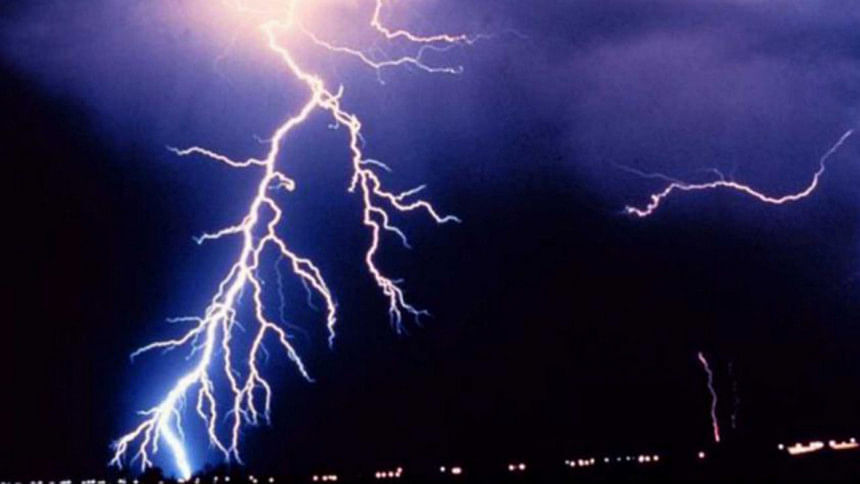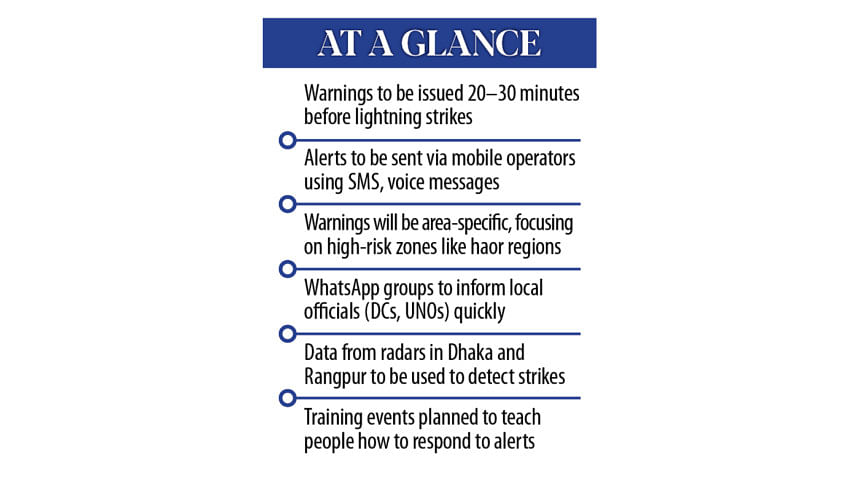Lightning alerts 20-30 minutes in advance

After failing to implement earlier projects such as planting palm trees and installing lightning arresters in high-risk areas, the interim government is now planning to introduce an early warning system to reduce lightning-related casualties.
Razwanur Rahman, director general of the Department of Disaster Management, said the Bangladesh Meteorological Department (BMD) is developing a system that will issue warnings 20 to 30 minutes before lightning strikes in specific areas.
"With early warnings, residents can take precautionary steps to protect themselves," he said. "We are trying to disseminate this information via mobile operators to areas at risk of lightning strikes. We also plan to open a WhatsApp group to quickly communicate alerts to local officials like DCs and UNOs."

Rahman said the initiative is a joint effort between the Department of Disaster Management and the BMD.
According to data from the Department of Disaster Management, 2,328 people were killed by lightning strikes between 2010 and 2020, with the highest annual death toll -- 359 -- in 2018.
Meanwhile, Save the Society and Thunderstorm Awareness Forum (SSTAF) reported that 1,536 people have died in the last six years since 2019. Of these, 265 died in 2019, 230 in 2020, 305 in 2021, 277 in 2022, 245 in 2023 and 214 in 2024.
Rashim Mollah, secretary of SSTAF, said 75 people were killed in lightning strikes between January and April this year, including 18 on April 28 alone.
Prof Kabirul Bashar, president of SSTAF, identified 10 high-risk areas -- Sunamganj, Habiganj, Kishoreganj, Netrokona, Sylhet, Chapainawabganj, Chattogram, Naogaon, Dinajpur, and Sirajganj.
Dr Shameem Hassan Bhuiyan, deputy director of BMD, said lightning accompanies thunderstorms and is categorised into three types -- cloud-to-cloud, cloud-to-air, and cloud-to-ground -- the last of which directly affects humans.
He said a storm warning centre has recently been established on the BMD premises and has shown promising results in detecting lightning strikes in advance. Radars in Dhaka and Rangpur are also providing relevant data.
"The key challenge is how to deliver timely alerts to those at risk before the lightning strikes," he said. "National broadcasts via radio and TV aren't enough, we need targeted alerts in specific zones."
Dr Bhuiyan said the BMD plans to use mobile network towers to send area-specific alerts through SMS broadcast mode. "We will use voice SMS to send alerts 20 to 30 minutes in advance so people can take necessary precautions," he added.
He emphasised the importance of public training, saying, "People must be educated on what actions to take after receiving alerts. NGOs, INGOs and disaster management authorities need to step in with training and guidelines."
He said haor areas are especially vulnerable because tall trees, which can act as natural lightning conductors, do not grow well in waterlogged conditions, leaving field workers exposed during dry seasons.
Lightning was declared a natural disaster in Bangladesh in 2016. Since then, authorities have attempted various strategies to reduce associated risks. In 2017, the Department of Disaster Management (DDM) initiated a plan to plant 3.8 million palm trees across rural areas, as these trees can serve as natural lightning arresters.
However, due to poor maintenance, the project was scrapped in 2022 by the former state minister for disaster management.
The ministry also proposed installing 6,793 lightning arresters and constructing 3,398 lightning shelters in 15 high-risk districts. However, Razwanur Rahman said the project lacked sustainability and failed to secure approval.
Dr Shameem said installing thousands of arresters and shelters is economically unfeasible. "It's doable at individual homes but not at scale. It's too costly," he said.
Regarding palm trees, he said, "They take time to grow, and many landowners refuse to allow them. Planting them along roadsides is risky, as the area within four metres of a lightning-struck tree remains dangerous."
The DG of the Department of Disaster Management said they are still negotiating with mobile operators and cannot comment on costs at this stage. They will select the most vulnerable areas for the lightning warning system, he added.

 For all latest news, follow The Daily Star's Google News channel.
For all latest news, follow The Daily Star's Google News channel. 



Comments